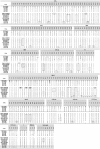Bovine-like coronaviruses isolated from four species of captive wild ruminants are homologous to bovine coronaviruses, based on complete genomic sequences
- PMID: 18842722
- PMCID: PMC2593316
- DOI: 10.1128/JVI.01586-08
Bovine-like coronaviruses isolated from four species of captive wild ruminants are homologous to bovine coronaviruses, based on complete genomic sequences
Abstract
We sequenced and analyzed the full-length genomes of four coronaviruses (CoVs), each from a distinct wild-ruminant species in Ohio: sambar deer (Cervus unicolor), a waterbuck (Kobus ellipsiprymnus), a sable antelope (Hippotragus niger), and a white-tailed deer (Odocoileus virginianus). The fecal samples from the sambar deer, the waterbuck, and the white-tailed deer were collected during winter dysentery outbreaks and sporadic diarrhea cases in 1993 and 1994 (H. Tsunemitsu, Z. R. el-Kanawati, D. R. Smith, H. H. Reed, and L. J. Saif, J. Clin. Microbiol. 33:3264-3269, 1995). A fecal sample from a sable antelope was collected in 2003 from an Ohio wild-animal habitat during the same outbreak when a bovine-like CoV from a giraffe (GiCoV) was isolated (M. Hasoksuz, K. Alekseev, A. Vlasova, X. Zhang, D. Spiro, R. Halpin, S. Wang, E. Ghedin, and L. J. Saif, J. Virol. 81:4981-4990, 2007). For two of the CoVs (sambar deer and waterbuck), complete genomes from both the cell culture-adapted and gnotobiotic-calf-passaged strains were also sequenced and analyzed. Phylogenetically, wild-ruminant CoVs belong to group 2a CoVs, with the closest relatedness to recent bovine CoV (BCoV) strains. High nucleotide identities (99.4 to 99.6%) among the wild-ruminant strains and recent BCoV strains (BCoV-LUN and BCoV-ENT, isolated in 1998) further confirm the close relatedness. Comparative genetic analysis of CoVs of captive wild ruminants with BCoV strains suggests that no specific genomic markers are present that allow discrimination between the bovine strains and bovine-like CoVs from captive wild ruminants; furthermore, no specific genetic markers were identified that defined cell cultured or calf-passaged strains or the host origin of strains. The results of this study confirm prior reports of biologic and antigenic similarities between bovine and wild-ruminant CoVs and suggest that cattle may be reservoirs for CoVs that infect captive wild ruminants or vice versa and that these CoVs may represent host range variants of an ancestral CoV.
Figures



Similar articles
-
Biologic, antigenic, and full-length genomic characterization of a bovine-like coronavirus isolated from a giraffe.J Virol. 2007 May;81(10):4981-90. doi: 10.1128/JVI.02361-06. Epub 2007 Mar 7. J Virol. 2007. PMID: 17344285 Free PMC article.
-
Quasispecies of bovine enteric and respiratory coronaviruses based on complete genome sequences and genetic changes after tissue culture adaptation.Virology. 2007 Jun 20;363(1):1-10. doi: 10.1016/j.virol.2007.03.018. Epub 2007 Apr 16. Virology. 2007. PMID: 17434558 Free PMC article.
-
Bovine-like coronaviruses in domestic and wild ruminants.Anim Health Res Rev. 2018 Dec;19(2):113-124. doi: 10.1017/S1466252318000117. Anim Health Res Rev. 2018. PMID: 30683171 Free PMC article. Review.
-
Isolation of coronaviruses antigenically indistinguishable from bovine coronavirus from wild ruminants with diarrhea.J Clin Microbiol. 1995 Dec;33(12):3264-9. doi: 10.1128/jcm.33.12.3264-3269.1995. J Clin Microbiol. 1995. PMID: 8586714 Free PMC article.
-
Bovine Coronavirus and the Associated Diseases.Front Vet Sci. 2021 Mar 31;8:643220. doi: 10.3389/fvets.2021.643220. eCollection 2021. Front Vet Sci. 2021. PMID: 33869323 Free PMC article. Review.
Cited by
-
First isolation of bovine coronavirus with a three-amino-acid deletion in the N gene causing severe respiratory and digestive disease in calve.Front Microbiol. 2024 Oct 1;15:1466096. doi: 10.3389/fmicb.2024.1466096. eCollection 2024. Front Microbiol. 2024. PMID: 39411436 Free PMC article.
-
Recent evolutionary origin and localized diversity hotspots of mammalian coronaviruses.Elife. 2024 Aug 28;13:RP91745. doi: 10.7554/eLife.91745. Elife. 2024. PMID: 39196812 Free PMC article.
-
Prevalence of coronaviruses in European bison (Bison bonasus) in Poland.Sci Rep. 2024 Jun 5;14(1):12928. doi: 10.1038/s41598-024-63717-1. Sci Rep. 2024. PMID: 38839918 Free PMC article.
-
Genetic characterization of bovine coronavirus strain isolated in Inner Mongolia of China.BMC Vet Res. 2024 May 18;20(1):209. doi: 10.1186/s12917-024-04046-3. BMC Vet Res. 2024. PMID: 38760785 Free PMC article.
-
A comprehensive molecular analysis of bovine coronavirus strains isolated from Brazil and comparison of a wild-type and cell culture-adapted strain associated with respiratory disease.Braz J Microbiol. 2024 Jun;55(2):1967-1977. doi: 10.1007/s42770-024-01287-0. Epub 2024 Feb 21. Braz J Microbiol. 2024. PMID: 38381350
References
-
- Almeida, J. D., D. M. Berry, C. H. Cunningham, D. Hamre, M. S. Hofstad, L. Mallucci, K. McIntosh, and D. A. J. Tyrrell. 1968. Coronaviruses. Nature 220650.
-
- Brandao, P. E., F. Gregori, L. J. Richtzenhain, C. A. Rosales, L. Y. Villarreal, and J. A. Jerez. 2006. Molecular analysis of Brazilian strains of bovine coronavirus (BCoV) reveals a deletion within the hypervariable region of the S1 subunit of the spike glycoprotein also found in human coronavirus OC43. Arch. Virol. 1511735-1748. - PMC - PubMed
Publication types
MeSH terms
Grants and funding
LinkOut - more resources
Full Text Sources
Research Materials
Miscellaneous

